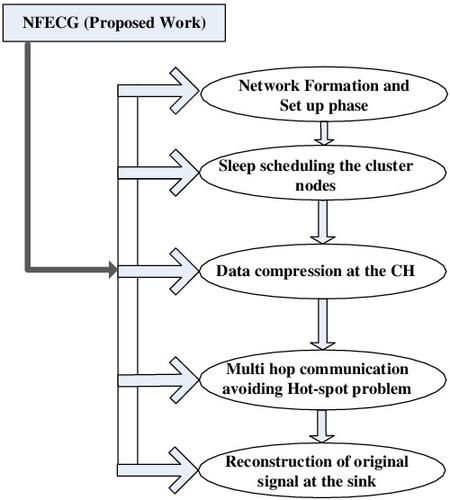当前位置:
X-MOL 学术
›
Int. J. Commun. Syst.
›
论文详情
Our official English website, www.x-mol.net, welcomes your
feedback! (Note: you will need to create a separate account there.)
A novel framework for energy‐efficient compressive data gathering in heterogeneous wireless sensor network
International Journal of Communication Systems ( IF 1.7 ) Pub Date : 2020-11-18 , DOI: 10.1002/dac.4677 Rachit Manchanda 1 , Kanika Sharma 1
International Journal of Communication Systems ( IF 1.7 ) Pub Date : 2020-11-18 , DOI: 10.1002/dac.4677 Rachit Manchanda 1 , Kanika Sharma 1
Affiliation

|
Wireless sensor network (WSN) suffers from the energy‐limited sensor nodes which consume energy heavily depending upon the magnitude of data which is transmitted or received by the nodes in the network. In this paper, our primary aim is to reduce the quantity of data transmitted to the data‐collecting sink, which helps in the energy preservation and eventually leads to network longevity. To address this concern, in this paper, we propose a novel framework for energy‐efficient compressive data gathering (NFECG) for heterogeneous WSN. NFECG works in four following phases; in the first phase, the cluster head (CH) selection is performed by considering remaining energy, “distance within the nodes and the sink,” and node density; in second phase, sleep scheduling is done among the cluster member nodes; further, in third phase, the compression of the aggregated data is performed at the CH level, and equivalent compressed sparse signals are generated which are transmitted to sink. In the last phase, at the sink, decompression is applied to retrieve the original signals. The simulation of NFECG is performed using MATLAB under two cases of different network area and number of nodes. We examine its performance for various performance metrics and also inspect for its scalable characteristics. The results show that for one of the two cases, it improves stability period and network lifetime by 52.59% and 46.09%, respectively, as compared to energy‐adjusted high‐level data total tree (EHDT) protocol, and also for the other case of network configuration, it acquires supreme performance.
中文翻译:

异构无线传感器网络中高效节能压缩数据收集的新框架
无线传感器网络(WSN)受到能量受限的传感器节点的困扰,该节点大量消耗能量,具体取决于网络中节点发送或接收的数据量。在本文中,我们的主要目的是减少传输到数据收集接收器的数据量,这有助于节能并最终导致网络寿命。为了解决这个问题,在本文中,我们提出了一种用于异构WSN的节能压缩数据收集(NFECG)的新颖框架。NFECG在以下四个阶段中工作;在第一阶段,通过考虑剩余能量,“节点与宿之间的距离”以及节点密度来进行簇头(CH)的选择。在第二阶段,在集群成员节点之间进行睡眠调度。此外,在第三阶段,聚合数据的压缩在CH级别执行,并生成等效的压缩稀疏信号,这些信号被发送到接收器。在最后一个阶段,在接收器上,进行解压缩以获取原始信号。NFECG的仿真是使用MATLAB在网络面积和节点数量不同的两种情况下进行的。我们针对各种性能指标检查其性能,并检查其可扩展特性。结果表明,与能源调整后的高级数据总树(EHDT)协议相比,对于这两种情况之一,它分别将稳定期和网络寿命提高了52.59%和46.09%。网络配置的优势,它获得了卓越的性能。并生成等效的压缩稀疏信号,然后将其发送到接收器。在最后一个阶段,在接收器上,进行解压缩以获取原始信号。NFECG的仿真是使用MATLAB在网络面积和节点数量不同的两种情况下进行的。我们针对各种性能指标检查其性能,并检查其可扩展特性。结果表明,与能源调整后的高级数据总树(EHDT)协议相比,对于这两种情况之一,它分别将稳定期和网络寿命提高了52.59%和46.09%。网络配置的优势,它获得了卓越的性能。并生成等效的压缩稀疏信号,然后将其发送到接收器。在最后一个阶段,在接收器上,进行解压缩以获取原始信号。NFECG的仿真是使用MATLAB在网络面积和节点数量不同的两种情况下进行的。我们针对各种性能指标检查其性能,并检查其可扩展特性。结果表明,与能源调整后的高级数据总树(EHDT)协议相比,对于这两种情况之一,它分别将稳定期和网络寿命提高了52.59%和46.09%。网络配置的优势,它获得了卓越的性能。NFECG的仿真是使用MATLAB在网络面积和节点数量不同的两种情况下进行的。我们针对各种性能指标检查其性能,并检查其可扩展特性。结果表明,与能源调整后的高级数据总树(EHDT)协议相比,对于这两种情况之一,它分别将稳定期和网络寿命提高了52.59%和46.09%。网络配置的优势,它获得了卓越的性能。NFECG的仿真是使用MATLAB在网络面积和节点数量不同的两种情况下进行的。我们针对各种性能指标检查其性能,并检查其可扩展特性。结果表明,与能源调整后的高级数据总树(EHDT)协议相比,对于这两种情况之一,它分别将稳定期和网络寿命提高了52.59%和46.09%。网络配置的优势,它获得了卓越的性能。
更新日期:2021-01-04
中文翻译:

异构无线传感器网络中高效节能压缩数据收集的新框架
无线传感器网络(WSN)受到能量受限的传感器节点的困扰,该节点大量消耗能量,具体取决于网络中节点发送或接收的数据量。在本文中,我们的主要目的是减少传输到数据收集接收器的数据量,这有助于节能并最终导致网络寿命。为了解决这个问题,在本文中,我们提出了一种用于异构WSN的节能压缩数据收集(NFECG)的新颖框架。NFECG在以下四个阶段中工作;在第一阶段,通过考虑剩余能量,“节点与宿之间的距离”以及节点密度来进行簇头(CH)的选择。在第二阶段,在集群成员节点之间进行睡眠调度。此外,在第三阶段,聚合数据的压缩在CH级别执行,并生成等效的压缩稀疏信号,这些信号被发送到接收器。在最后一个阶段,在接收器上,进行解压缩以获取原始信号。NFECG的仿真是使用MATLAB在网络面积和节点数量不同的两种情况下进行的。我们针对各种性能指标检查其性能,并检查其可扩展特性。结果表明,与能源调整后的高级数据总树(EHDT)协议相比,对于这两种情况之一,它分别将稳定期和网络寿命提高了52.59%和46.09%。网络配置的优势,它获得了卓越的性能。并生成等效的压缩稀疏信号,然后将其发送到接收器。在最后一个阶段,在接收器上,进行解压缩以获取原始信号。NFECG的仿真是使用MATLAB在网络面积和节点数量不同的两种情况下进行的。我们针对各种性能指标检查其性能,并检查其可扩展特性。结果表明,与能源调整后的高级数据总树(EHDT)协议相比,对于这两种情况之一,它分别将稳定期和网络寿命提高了52.59%和46.09%。网络配置的优势,它获得了卓越的性能。并生成等效的压缩稀疏信号,然后将其发送到接收器。在最后一个阶段,在接收器上,进行解压缩以获取原始信号。NFECG的仿真是使用MATLAB在网络面积和节点数量不同的两种情况下进行的。我们针对各种性能指标检查其性能,并检查其可扩展特性。结果表明,与能源调整后的高级数据总树(EHDT)协议相比,对于这两种情况之一,它分别将稳定期和网络寿命提高了52.59%和46.09%。网络配置的优势,它获得了卓越的性能。NFECG的仿真是使用MATLAB在网络面积和节点数量不同的两种情况下进行的。我们针对各种性能指标检查其性能,并检查其可扩展特性。结果表明,与能源调整后的高级数据总树(EHDT)协议相比,对于这两种情况之一,它分别将稳定期和网络寿命提高了52.59%和46.09%。网络配置的优势,它获得了卓越的性能。NFECG的仿真是使用MATLAB在网络面积和节点数量不同的两种情况下进行的。我们针对各种性能指标检查其性能,并检查其可扩展特性。结果表明,与能源调整后的高级数据总树(EHDT)协议相比,对于这两种情况之一,它分别将稳定期和网络寿命提高了52.59%和46.09%。网络配置的优势,它获得了卓越的性能。











































 京公网安备 11010802027423号
京公网安备 11010802027423号